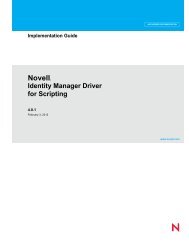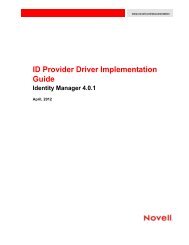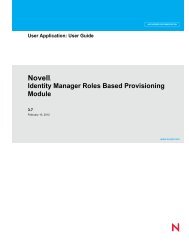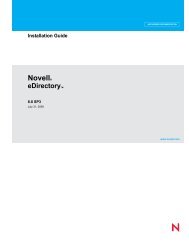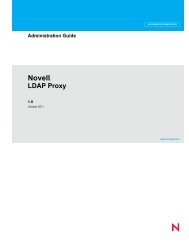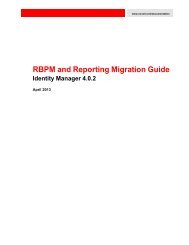Novell iManager 2.7.5 Administration Guide - NetIQ
Novell iManager 2.7.5 Administration Guide - NetIQ
Novell iManager 2.7.5 Administration Guide - NetIQ
Create successful ePaper yourself
Turn your PDF publications into a flip-book with our unique Google optimized e-Paper software.
5.7.3 Viewing Class Information<br />
The Class Information page displays information about the selected class and lets you add attributes.<br />
During class creation, if the class is specified to inherit attributes from another class, the inherited<br />
attributes are classified as they are in the parent class. For instance, if Object Class is a mandatory<br />
attribute for the parent class, then it displays on this screen as a mandatory attribute for the selected<br />
class.<br />
To see a Class’s information:<br />
1 In Roles and Tasks, select Schema > Class Information.<br />
2 Select the class for which you want to see information, then click View.<br />
The Content frame displays information related to the selected class. To add an attribute to the<br />
class, select Add a new attribute. To view the class’s parent class, select View superclass.<br />
3 When finished, click Close.<br />
5.7.4 Creating an Attribute<br />
You can define your own custom types of attributes and add them as optional attributes to existing<br />
object classes. However, you cannot add mandatory attributes to existing classes. To create an<br />
attribute:<br />
1 In Roles and Tasks, click Schema > Create Attribute.<br />
2 Follow the steps in the Create Attribute Wizard to complete the attribute creation procedure.<br />
5.7.5 Creating a Class<br />
An auxiliary class is a set of properties (attributes) added to particular object rather than to an entire<br />
class of objects. For example, an e‐mail application could extend the schema of your eDirectory tree<br />
to include an E‐Mail Properties auxiliary class and then extend individual objects with those<br />
properties as needed.<br />
Using Schema Manager, you can define your own auxiliary classes. You can then extend individual<br />
objects with the properties defined in your auxiliary classes. To create an auxiliary class:<br />
1 In Roles and Tasks, click Schema > Create Class.<br />
2 Follow the steps in the Create Class Wizard to define the new class.<br />
5.7.6 Deleting an Attribute<br />
You can delete unused attributes that aren’t part of the base schema of your eDirectory tree. This<br />
might be useful after merging two directory trees, or if an attribute has become obsolete over time. To<br />
delete an attribute:<br />
1 In Roles and Tasks, click Schema > Delete Attribute.<br />
2 Select the attribute you want to delete, then click Delete.<br />
Only attributes that you can delete are displayed.<br />
Roles and Tasks 47




